Waterfall
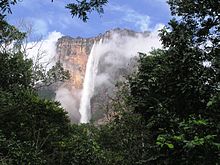

A waterfall is a place where flowing water rapidly drops in elevation as it flows over a steep region or a cliff.
Formation

Waterfalls are commonly formed when a river is young.[1] At these times the channel is often narrow and deep. When the river courses over resistant bedrock, erosion happens slowly, while downstream the erosion occurs more rapidly.[1][2] As the watercourse increases its velocity at the edge of the waterfall, it plucks material from the riverbed. Whirlpools created in the turbulence as well as sand and stones carried by the watercourse increase the erosion capacity.[1] This causes the waterfall to carve deeper into the bed and to recede upstream. Often over time, the waterfall will recede back to form a canyon or gorge downstream as it recedes upstream, and it will carve deeper into the ridge above it.[3] The rate of retreat for a waterfall can be as high as one and half meters per year.[1]
Often, the rock stratum just below the more resistant shelf will be of a softer type, meaning that undercutting due to splashback will occur here to form a shallow cave-like formation known as a rock shelter under and behind the waterfall. Eventually, the outcropping, more resistant cap rock will collapse under pressure to add blocks of rock to the base of the waterfall. These blocks of rock are then broken down into smaller boulders by attrition as they collide with each other, and they also erode the base of the waterfall by abrasion, creating a deep plunge pool or gorge.
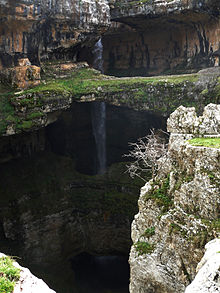
Streams become wider and shallower just above waterfalls due to flowing over the rock shelf, and there is usually a deep area just below the waterfall because of the kinetic energy of the water hitting the bottom. Waterfalls normally form in a rocky area due to erosion. After a long period of being fully formed, the water falling off the ledge will retreat, causing a horizontal pit parallel to the waterfall wall. Eventually, as the pit grows deeper, the waterfall collapses to be replaced by a steeply sloping stretch of river bed.[1] In addition to gradual processes such as erosion, earth movement caused by earthquakes or landslides or volcanoes can cause a differential in land heights which interfere with the natural course of a water flow, and result in waterfalls.
A river sometimes flows over a large step in the rocks that may have been formed by a fault line. Waterfalls can occur along the edge of a glacial trough, whereby a stream or river flowing into a glacier continues to flow into a valley after the glacier has receded or melted. The large waterfalls in Yosemite Valley are examples of this phenomenon, which is referred to as a hanging valley. Another reason hanging valleys may form is where two rivers join and one is flowing faster than the other.[1] Waterfalls can be grouped into ten broad classes based on the average volume of water present on the fall (which depends on both the waterfall's average flow and its height) using a logarithmic scale. Class 10 waterfalls include Niagara Falls, Paulo Afonso Falls and Khone Falls.
Classes of other well-known waterfalls include Victoria Falls and Kaieteur Falls (Class 9); Rhine Falls and Gullfoss (Class 8); Angel Falls and Dettifoss (Class 7); Yosemite Falls, Lower Yellowstone Falls and Umphang Thee Lor Sue Waterfall (Class 6); Sutherland Falls (Class 5).[4]
Types
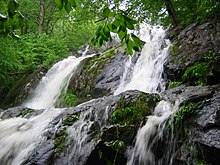
- Block: Water descends from a relatively wide stream or river.[2][5]
- Cascade: Water descends a series of rock steps.[2][5]
- Cataract: A large, powerful waterfall.[5]
- Chute: A large quantity of water forced through a narrow, vertical passage.[5]
- Fan: Water spreads horizontally as it descends while remaining in contact with bedrock.[5]
- Frozen: Any waterfall which has some element of ice.[5]
- Horsetail: Descending water maintains some contact with bedrock.[5]
- Plunge: Water descends vertically, losing contact with the bedrock surface.[5]
- Punchbowl: Water descends in a constricted form and then spreads out in a wider pool.[5]
- Segmented: Distinctly separate flows of water form as it descends.[5]
- Tiered: Water drops in a series of distinct steps or falls.[5]
- Multi-step: A series of waterfalls one after another of roughly the same size each with its own sunken plunge pool.[5]
Examples of famous waterfalls


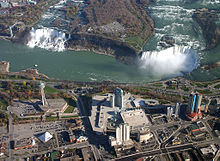
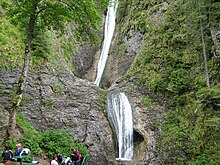
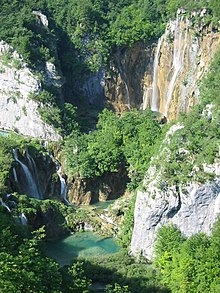
Significant waterfalls,[6] listed alphabetically:
- Angel Falls in Venezuela is the world's tallest at 979 metres (3,212 ft).
- Bambarakanda Falls is Sri Lanka's tallest waterfall at 263 metres (863 ft).
- Detian - Ban Gioc Falls is the 4th largest international waterfall in the world between the Sino-Vietnamese border.
- Bridalveil Fall in Yosemite Valley is 189 metres (620 ft) high with a sheer drop when flowing.
- Cascata delle Marmore in Italy is the tallest man-made waterfall in the world.
- Cautley Spout, at 175 metres (574 ft), is the tallest waterfall in England.
- Dettifoss in northeast Iceland is the largest waterfall in Europe in terms of volume discharge, having an average water flow of 200 m³/s.The falls are 100 metres (330 ft) wide and have a drop of 44 metres (144 ft) down to the Jökulsárgljúfur canyon.
- Eas a' Chual Aluinn in Scotland, at 200 metres (660 ft), the tallest waterfall in the United Kingdom.
- Falls of Lora, also in Scotland is an unusual rapids in the sea that is created when the waters in Loch Etive pour out through the narrow mouth of the loch over a rocky shelf.[7]
- Gocta is the fifth tallest in the world at 771 metres (2,530 ft) and is located in the province of Chachapoyas, Peru.
- Hannoki Falls in Tateyama, Japan, is the tallest waterfall in Japan at 500 metres (1,600 ft).
- Jiao Lung Waterfall in Alishan, Chiayi, Taiwan, is the tallest waterfall in East Asia at 600 metres (2,000 ft).
- High Force on the River Tees is one of the tallest waterfalls in England.
- Huangguoshu Waterfall in Anshun, Guizhou, China, is the largest waterfall in East Asia.
- Iguazu Falls is a tall and extremely wide waterfall located in South America on the Argentina/Brazil border.
- James Bruce Falls, the tallest waterfall in North America at 840 metres (2,760 ft), is located in the Princess Louisa Marine Provincial Park, British Columbia, Canada.
- Jurong Falls in Singapore is an artificial waterfall.
- Kaieteur Falls (Potaro River in central Guyana), located in the Kaieteur National Park, is 226 metres (741 ft).
- Krimmler Wasserfälle, at 380 metres (1,250 ft), is Austria's second-tallest waterfall and is located in Krimml, Salzburg.
- Niagara Falls are the most powerful falls in North America.
- Nohkalikai Falls is India's tallest plunge waterfall, located in Meghalaya state, India.
- Pissing Mare Falls, at 350 metres (1,150 ft), is the tallest in eastern North America.
- Pistyll Rhaeadr, 73 metres (240 ft), is the tallest waterfall in Wales.
- Ramnefjellsfossen is the world's third tallest at 808 metres (2,651 ft), at Stryn, Nesdalen, Norway.
- Venta Rapid is Europe's widest and is located in Latvia.
- Shir-Abad Waterfall is located near Khan Bebin in Golestan Province, Iran.
- Shoshone Falls the "Niagara of the West" in Idaho.
- St.Clair's Falls is Sri Lanka's widest waterfall and is 265 feet (81 m) tall.
- Silver Falls is a waterfall and is located in Silverton, Oregon.
- Takakkaw Falls, 384 metres (1,260 ft) high, are in Yoho National Park in Canada.
- Taquaruçu waterfalls. In valley near Palmas (Brazil), this village is famous for its many waterfalls.
- Tequendama Falls is a 132-metre (433 ft) waterfall on the Bogotá River, about 30 kilometres (19 mi) southwest of Bogotá in Colombia.
- Tugela Falls is the world's second tallest at 947 metres (3,107 ft) in KwaZulu-Natal province, Republic of South Africa.
- Victoria Falls is the largest waterfall in the world and is more than a mile long. It is located on the Zambezi river on the border of Zimbabwe and Zambia.
- Virginia Falls (Northwest Territories) on South Nahanni River, Northwest Territories, Canada. World's 14th largest waterfall located in Nahanni National Park Reserve a UNESCO World Heritage Site.
- Waihilau Falls, at 792 metres (2,598 ft), is located in the Waimanu Valley, Hawaii, United States.
- Yosemite Falls, the fourth tallest waterfall in North America at 739 metres (2,425 ft), is located in Yosemite National Park, United States.
- Yumbilla Falls is the world's fifth tallest waterfall and located in Peru.
-
The largest indoor waterfall in the world, at the International Center, in Detroit.
-
Whangarei Falls in New Zealand is an example of a plunge waterfall.
-
Camaya Waterfalls-3 in Camaya Coast, Mariveles, Bataan, Philippines is a horsetail-punchbowl waterfall.
-
Berry Creek Falls in Big Basin Redwoods State Park, California, is an example of a cascade waterfall.
-
Sempervirens Falls in Big Basin Redwoods State Park, California, is an example of a plunge-punchbowl waterfall.
-
Ban Gioc – Detian Falls in the Sino-Vietnamese border is separated into three-tiered falls by rocks and trees
Some waterfalls are constructed by artificial means indoors. The largest of these is in the lobby of the International Center, in Detroit.[8]
See also
- List of waterfalls
- List of waterfalls by height
- List of waterfalls by flow rate
- List of waterfalls by type
- Panhole
- Stream pool
- Tributary
- Water feature
- Waterfalls Bagging
References
- ^ a b c d e f Carreck, Rosalind, ed. (1982). The Family Encyclopedia of Natural History. The Hamlyn Publishing Group. pp. 246–248. ISBN 011202257.
{{cite book}}: Check|isbn=value: length (help) - ^ a b c http://geography.howstuffworks.com/terms-and-associations/waterfall.htm/printable
- ^ http://www.classzone.com/books/earth_science/terc/content/visualizations/es1305/es1305page01.cfm?chapter_no=visualization
- ^ Richard H. Beisel Jr., International Waterfall Classification System, Outskirts Press, 2006 ISBN 1-59800-340-2
- ^ a b c d e f g h i j k l http://worldwaterfalls.com/waterfall_types.php
- ^ World Waterfall Database
- ^ "Falls of Lora Information" The Falls of Lora. Retrieved 18 Sept 2011.
- ^ Scholastic Book of World Records 2009. Scholastic. 2008. p. 267. ISBN 978-0-545-08211-2.








